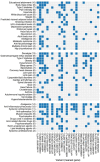This is a preprint.
The genetic architecture of fibromyalgia across 2.5 million individuals
- PMID: 41001472
- PMCID: PMC12458511
- DOI: 10.1101/2025.09.18.25335914
The genetic architecture of fibromyalgia across 2.5 million individuals
Abstract
Fibromyalgia is a common and debilitating chronic pain syndrome of poorly understood etiology. Here, we conduct a multi-ancestry genome-wide association study meta-analysis across 2,563,755 individuals (54,629 cases and 2,509,126 controls) from 11 cohorts, identifying the first 26 risk loci for fibromyalgia. The strongest association was with a coding variant in HTT, the causal gene for Huntington's disease. Gene prioritization implicated the HTT regulator GPR52, as well as diverse genes with neural roles, including CAMKV, DCC, DRD2/NCAM1, MDGA2, and CELF4. Fibromyalgia heritability was exclusively enriched within brain tissues and neural cell types. Fibromyalgia showed strong, positive genetic correlation with a wide range of chronic pain, psychiatric, and somatic disorders, including genetic correlations above 0.7 with low back pain, post-traumatic stress disorder and irritable bowel syndrome. Despite large sex differences in fibromyalgia prevalence, the genetic architecture of fibromyalgia was nearly identical between males and females. This work provides the first robust genetic evidence defining fibromyalgia as a central nervous system disorder, thereby establishing a biological framework for its complex pathophysiology and extensive clinical comorbidities.
Conflict of interest statement
CMB is a consultant for Vertex Pharmaceuticals and Merck Pharmaceuticals providing expert medicolegal testimony. SF is a consultant for Vertex Pharmaceuticals. BG has received research grants (paid to institution) from Sandoz, AbbVie, AlfaSigma, and Eli Lilly. SB has ownership interests in Hoba Therapeutics Aps, Novo Nordisk A/S, Lundbeck A/S, and Eli Lilly and Co. CE has received unrestricted research grants from Novo Nordisk and Abbott Diagnostics (administered by Aarhus University Hospital, no personal fees received). GB, TET, GET, TAO, SS, HS, IJ, ATS, GT, LS, UT, PS, and DFG are employees of Amgen deCODE Genetics.
Figures





References
-
- Häuser W. et al. Fibromyalgia. Nat. Rev. Dis. Primer 1, 1–16 (2015).
-
- Bair M. J. & Krebs E. E. Fibromyalgia. Ann. Intern. Med. 172, ITC33–ITC48 (2020). - PubMed
-
- Sarzi-Puttini P., Giorgi V., Marotto D. & Atzeni F. Fibromyalgia: an update on clinical characteristics, aetiopathogenesis and treatment. Nat. Rev. Rheumatol. 16, 645–660 (2020). - PubMed
-
- Clauw D. J. Fibromyalgia: a clinical review. JAMA 311, 1547–1555 (2014). - PubMed
-
- Schaefer C. et al. The Comparative Burden of Chronic Widespread Pain and Fibromyalgia in the United States. Pain Pract. Off. J. World Inst. Pain 16, 565–579 (2016).
Publication types
Grants and funding
LinkOut - more resources
Full Text Sources
Research Materials
Miscellaneous
